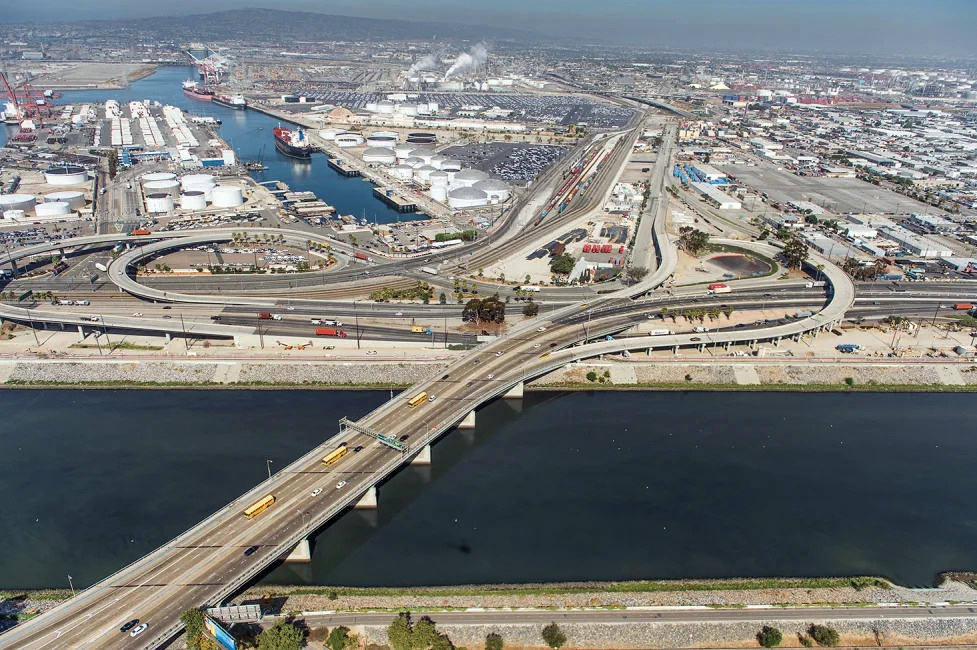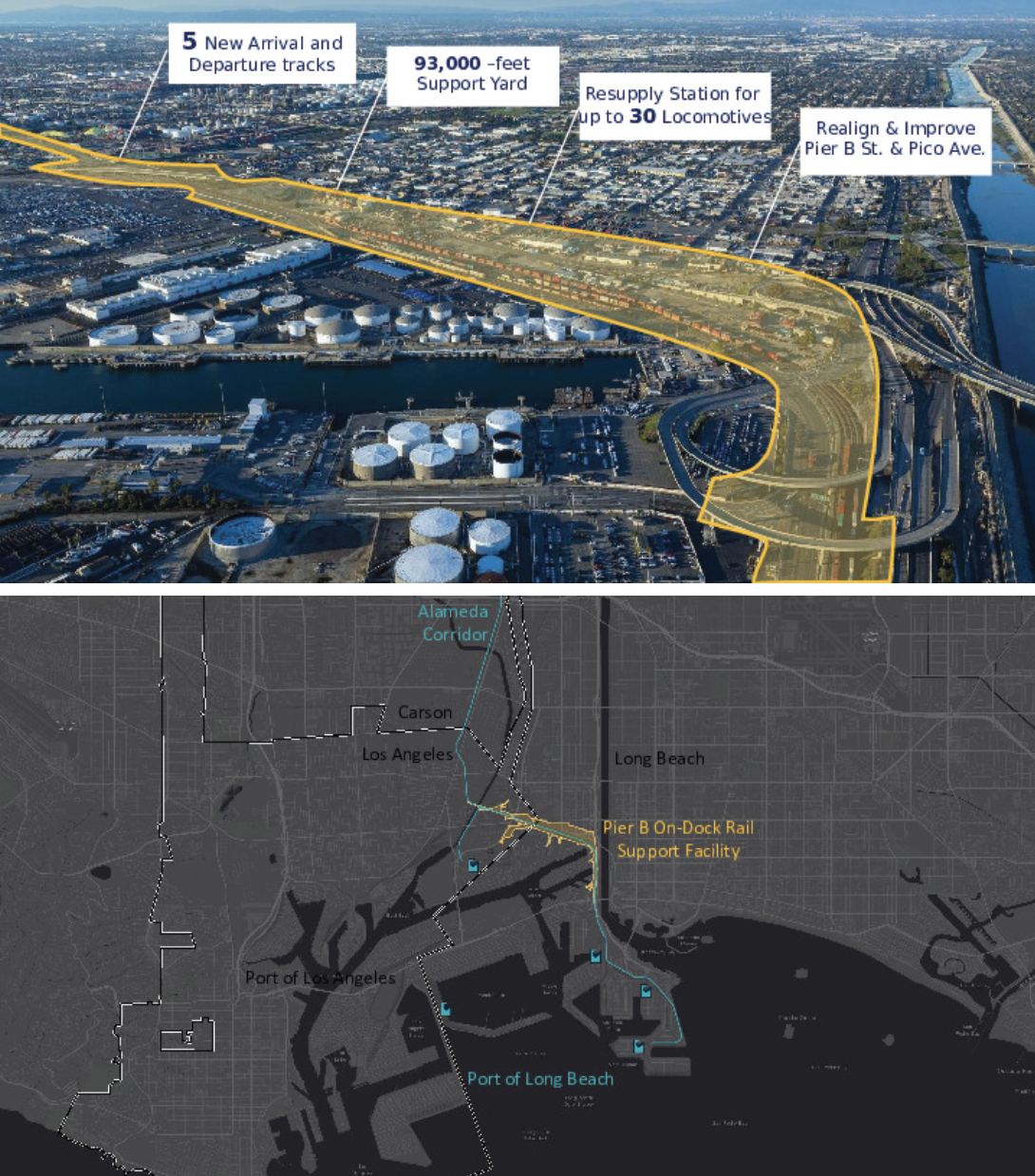
Without much fanfare, the stage is being set for a $1.55 billion, decade-long project to nearly double the Port of Long Beach’s (POLB) on-dock rail-service capability.
The project is advancing as Long Beach plans for a continuation of growth after its 2021 record of handling 9.4 million TEU (twenty-foot equivalent units), a 16% increase. The goal for the project is to move as much as 35% of cargo through on-dock rail, compared to roughly 20% today. Construction is set to begin next year.
Port Executive Director Mario Cordero summed up the project.
“The Pier B On-Dock Rail Support Facility advances all our goals for accelerating the flow of cargo: increasing on-dock rail efficiency, reducing shipping costs and shrinking the supply chain’s carbon footprint,” Cordero explained.
A few statistics capture the scope of the project.
Upon completion, on-dock rail capacity at the port is expected to more than double to nearly 5 million TEU. With the building of 18 miles of real track, the amount of storage space is set to more than quadruple. Five new arrival and departure tracks are planned alongside the increased storage.
“We are changing the (train building) process to something that can be much better planned,” said Sean Gamette, managing director of the POLB’s engineering bureau. “The goal is to better match Pacific origin and destination points with more and more inland U.S. locations, with greater reliability and more frequent service.”
A combined annual average of 5.6 million TEUs are moved through on-dock rail at POLB and the Port of Los Angeles, said Otis Cliatt II, president of Pacific Harbor Line, which provides rail transportation, maintenance and dispatching services to both ports.
PHL provides switching services for nine marine terminals, local customers and long-distance rail operators Burlington Northern Santa Fe Railway (BNSF) and Union Pacific (UP). The two carriers use the Alameda Corridor rail route between the ports and their own tracks that stretch to Chicago, the Southwest and other regions.
“We are trying to build a project that will have significant impact on rail infrastructure on top of a business that is quite active,” POLB Deputy Chief Harbor Engineer Mark Erickson said. The goal—to create more efficient staging space to build longer trains more quickly.
‘Game Changer’
On-dock rail was first launched at Long Beach in 1975. As on-dock rail’s popularity increased and BNSF as well as UP chose to operate longer trains, some of which are three miles long, challenges arose in handling trains efficiently in the limited space available.
“Pier B will be a huge game changer for Long Beach,” Cliatt said, because it will enable train crews to reduce the number of steps needed to build and receive those longer trains and lower the time needed to accomplish that task.
Dan Smith, a Tioga Group principal who has led multiple research projects for Southern California ports, outlined the challenges posed to on-dock rail.
“It’s very difficult to make large-scale changes,” Smith said. “As business changes in terminals and at the railroads, the ground changes under you. On-dock rail at Los Angeles and Long Beach was mostly done on a terminal-by-terminal basis with everybody learning as they went. In each case, they made the best fit they could at the time.”
An important feature of Pier B is its role in the broader mission of the port.
“The importance of on-dock rail is linked to other projects. We focus on all legs of the transportation network,” Gamette said.
Specifically, he mentioned construction of a new span known as the “Long Beach International Gateway” that replaced the now-retired Gerald Desmond Bridge. In addition, Gamette cited channel deepening projects to accommodate ever-larger vessels and a wharf expansion project at Middle Harbor.
From a broader perspective, the Pier B project is expected to add 1,135 new jobs in Long Beach, where one in five workers’ tasks are port related.
Another aspect of the Pier B project is a hoped-for reduction in truck traffic. Today, in addition to on-dock rail, intermodal cargo is moved by road to and from four inland locations where containers are loaded onto trains for shipments to and from a range of cities and regions, including Chicago, the East Coast and Texas.
One indicator of the trucking impact is the port’s statement that on-dock rail eliminates 2,000 truck trips for each double-stack freight train.
“The planners who are doing this project decided to be conservative and not bank on a specific reduction in truck trips,” Erickson said, because of the unknown pace of future trade growth.
Any reduction in truck trips would address current motor carrier industry sore points such as finding and retaining drivers, as well as managing chassis that often have been in short supply.

New Tools
For the railroad, Long Beach’s expansion creates new tools for PHL to cope with an industry trend known as Precision Scheduled Railroading that has increased the complexity of building ever-longer freight trains of all types. Longer trains typically increase the number of blocks, or groups, of containers being moved as well as the number of destinations for cargo in a single train, Cliatt explained.
Another challenge that the railroad faces is one that has become familiar to many other industries.
PHL faces a challenge in competing for workers, Cliatt said, because railroading is a 24-hour, outdoor business. He specifically praised both labor unions and his management team for their strong commitment to moving cargo during the past two years amid the effects of COVID and freight-market surges.
Projects like Pier B also could change the strategy of ocean carriers with regard to inland point intermodal, or IPI, according to Smith. Ocean carriers that have chosen to limit those inland container moves in an effort to minimize delays and congestion could increase inland shipments when reliability improves.
“Pier B should build resilience and reliability into the supply chain that will facilitate solutions to rail problems,” said Smith, who said two years of increased imports and supply-chain disruptions have taxed the capacity of a U.S. freight network that doesn’t have buffers, or reserve capacity, to cope with cargo surges. Reserve capacity has been difficult, he added, because of choices by cost-conscious rail managers.
Smith also identified the upside for beneficial cargo owners (BCOs).
“People complain all the time about prices. If you’re the VP of logistics and distribution for a major importer, then maybe you don’t get your bonus if costs go up. But if you don’t put stuff on the shelves you get fired. It’s all about putting stuff on the shelves.”
Long Beach has created a total of 12 different projects, each with its own budget and timeline, to complete the project. The last one is slated for completion in 2032. The first three are slated to be put out for bid in early-to-mid 2023.
The initial projects include linking two existing tracks to create the port’s first 10,000-foot-long track, and adding 2,500 feet to two existing tracks. Others include adding four tracks and lengthening four others, building a locomotive support facility and establishing paved trackside support lanes for service vehicles.
Although construction isn’t planned to start until next year, multiple milestones have already been reached. Late last year, the Transportation Department’s Maritime Administration awarded $52.3 million, the agency’s largest maritime grant, to help fund the project.
Final U.S. environmental approval was given in April. Additional permits still are needed, including one from the City of Los Angeles, since part of the expansion will occur in that jurisdiction.
More immediately, Long Beach is working on a $34.7-million project to create double track access in the south basin area from Pier G to Pier J. That project enables the building of trains to nearly 8,000 feet in length. State and local funds are paying for the project.
The Pier B project would also straighten out legacy problems, Smith said, such as grade crossings and local streets that weren’t big issues 20 years ago.
